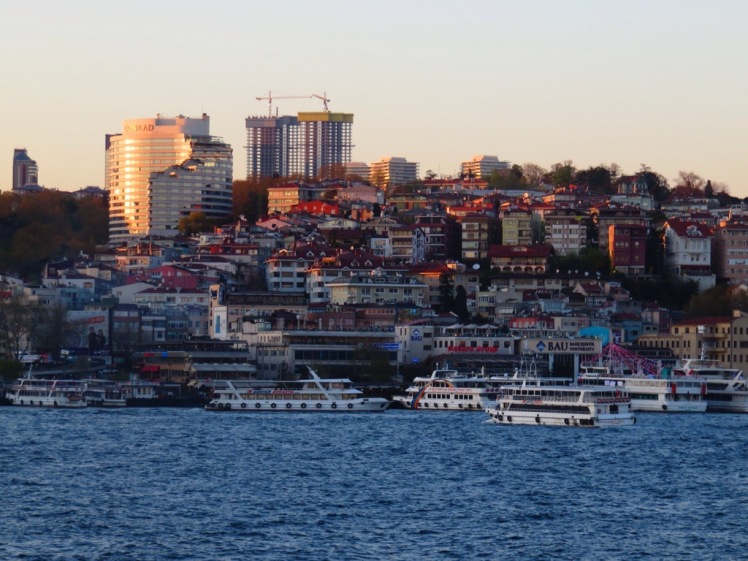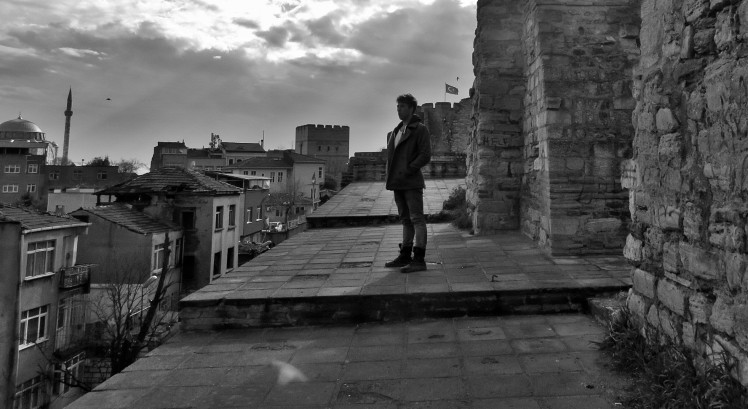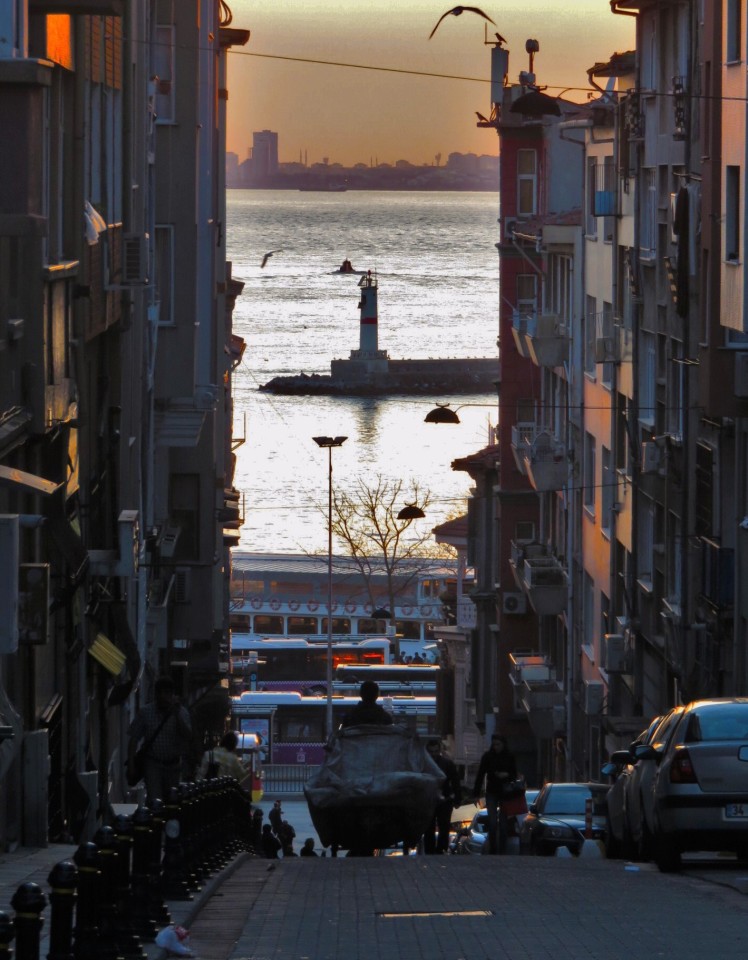Either I conquer Istanbul or Istanbul conquers me
Fatih Sultan Mehmet
Never have these words been more true. Arriving in Istanbul was a shock to the system. Suddenly the simplicity of “just walking” no longer existed. From the outskirts of the city I felt myself struck dumb at its size, the urban sprawl of grey, crazy traffic and apartment laden suburbs. And somewhere in amongst all the craziness, almost blotted out by the sprawling mass of modernity, is a lot of history. Where to go?

Istanbul is famous for so many things: the Agia Sofia, or the Blue Mosque, the grand bazar and spice bazar, but these have been covered a thousand times before by writers far more eloquent than me. Obviously I took in these sites but for my part Istanbul was more of a challenge than walking all those kilometres to be in that great city. Alone in the middle of a forest, or on my way to the top of a mountain, I’m at home, at peace. But inside a city I find myself lost – all my certainties evaporate in the great expanse, and it took me over a week to be able to accept, and appreciate, the city: to see beyond the the obvious and find a beating heart and soul.
Istanbul is a vast place. There are very conservative neighbourhoods, there are places that are upper class, Westernised, consuming Western culture
Orhan Pamuk
In a city the size of Istanbul it’s easy to lose yourself indefinitely. Within the tourist centre it’s a merry-go-round of hotels, touristic restaurants, Turkish delight sellers, kebab houses, carpets and rugs, and shops filled with antiques and I “heart” Istanbul memorabilia.
At first I felt as if I had popped a pill and stepped into some crazy hallucination, where colours and sounds are ultra tinted. An extreme waking in the dream world. After walking through tiny Turkish villages it was all too much for me to take in – busy, huge, and insane Istanbul. But it’s amazing how quickly you become de-sensitized to it all, and tell yourself that this is just “how it is”. You can either accept it, take a deep breath and join in, remembering that life has many aspects, or reject and stay on the edge. For a while I was simply overcome by the sheer size of the city and the all consuming nature of it.

And yet, despite all the chaos, the modern day Istanbul reels you in – there are so many possibilities. Underneath it all, Istanbul is bubbling, a simmering cauldron ready to explode. Scratch under the surface and you can find so many hidden treasures. It took me some time to become accustomed to the hectic way of this big city (I soon found myself rushing around from place to place, never really stopping to breathe, but always fighting time). I was hosted by amazing people and each time this lead me to another group, a network and chain of unending possibilities.
And so it was that I discovered a community of alternative, free thinkers, and different groups of young people who are creating a different, and sustainable view for the future.

“If one had but a single glance to give the world, one should gaze on Istanbul”
Alphonse de Lamartine
I spent a lot of time in Beşiktaş, a bubbling hub of bars and restaurants, with an atmosphere shaped by the young hipsters who are living and working there. But the modern world is always touched by the past in Istanbul, and as I discovered Beşiktaş is no different. Sitting without any fanfare, in the middle of a square by the waterfront, next to the busy main road with the roar of traffic speeding by, is a green domed turbe – a tomb. This is not uncommon all over Istanbul where tombs containing saints and sultans and their families are dotted at various points throughout the city, visited by pilgrims and well-wishers. However there is something particularly interesting about this tomb, as its occupant is neither saint nor sultan, but perhaps more sinner. In fact this is where the name comes from – Beşiktaş translates as “cradle of rock”. For this turbe belongs to Barbarossa, the famous pirate, and later admiral, of the Ottoman navy. The tomb of this great historical figure is set far back from the waterfront, which is now filled with the ferries which chug back and forth and along the Bosphorous. But originally it was placed at the waters edge, a tomb cradled within the hand-cut rocks, set at the edge of the hunting lands of the Ottoman Sultans, surrounded by green fields, park lands and trees, the sound of the waters lapping gently on the shore. It is a scene so far removed from the modern chaos that the contrast is startling.

However, despite all this I liked the area immediately. Originally I was hosted through Couchsurfing but then as I was wandering around the funky breakfast bars one Saturday morning, 3 young students smiled at me. I returned their happy grins, accepted their invitation to drink some Çay, and made a new family! I was invited to stay at their apartment, and it gave me a refuge, knowing I could retire to the safety of my friends when it all became too much. And from there I had a base to explore the great metropolis.
And so I took to the streets…
Wandering through neighbourhoods of Istanbul I felt that I was stepping between different cities, each one with a different atmosphere, its own set of architecture, rules and people.
But there is one region which sticks in my mind particularly, for the striking contrast of our modern world.

From the incredible suleymanye mosque, set amongst the sumptuous villas and university complex nearby, within 5 minutes you are in a shanty town. The opulence gives way to crumbling houses, dirt-smeared children kicking a ball in the street, groups of 20 -30 of the poorest gathered together to eat lunch, a “recycling centre” where boys and men arrive with their carts of rubbish dug out from the waste of the city. It’s a district of workers scratching a living from the bottom of the pile, sitting just next to the tourist hub of the grand bazaar and the Galata bridge with its constant rod waving fishermen.


This was the contradiction I felt. How can I justify the help I receive as I travel, and yet turn a blind eye to the glaring injustice that is so much a part of our world? Can I just walk on through, just another foreigner on my way to “see” the world?
THE GALATA BRIDGE
[across the Golden Horn]
Strolling on the bridge
I watch all of you with pleasure.
Some of you are pulling the oars, whispering,
some of you are picking oysters from the buoys,
some of you are holding the tillers of the barges,
some of you are ropemen at the hawsers;
some of you are birds, flying like poets;
some of you are fish, glittering, glittering;
some of you are boats, some of you are floats,
some of you are airy clouds.
Some of you are steamboats, dropping their smokestacks,
they sneak under the bridge;
some of you are whistles, blowing;
some of you are smoke, also blowing.
But all of you, all of you,
all of you worry about A Living.
Am I the only hedonist among you?
Don’t worry, maybe one day
I’ll write a poem about you.
I’ll make a penny or two (but not by writing)
and I’ll buy myself something to eat.
Orhan Veli
“All other cities are doomed, but I imagine that as long as people exist, Constantinople will exist.”
Petrus Gyllius
And what of the old city? Could I discover “Constantinople” in amongst all the modernity?
I searched for a taste of the ancient capital, but found it covered over by a blanket of consuming Western Culture. Where was Constantine’s glorious masterpiece, the Imperial capital of the Eastern Roman Empire?
My friend Sam flew in for a week from Hong Kong, and together we began exploring. One day we headed for an area a little way outside the central tourist hub to visit the “Chora Museum” (known as the Kariye Müzesi, which is actually only designated a museum so that they can charge an entry fee). In fact, it is a church, and was the centre of the Chora Monastery, a great building complex in the Eastern Roman Empire period, which stood outside the city walls built by Constantine. The building was called “Chora”, which means “in the country” or “outside of the city” in Greek. Inside are beautiful Byzantine frescoes, and though it sits outside the original boundaries of the city, nearby there is a section of the later City walls which you can climb for a sublime view of the city.
As we stood, looking out at the forest of houses, roads, and cars, and the explosion of the modern city, I think we were both able to picture a different scene: soldiers, standing on the ramparts, looking down at a spectacle as ancient as the city itself. I imagined armies through the ages, camped out in the modern day suburbs, the myriad lights of thousands of campfires twinkling and glowing in the gloom…

And suddenly we were in the old town, and history was all around us.
If you are a dreamer, come in
If you are a dreamer, a wisher, a liar,
A Hope-er, a Pray-er, a Magic Bean buyer,
If you’re a pretender, come sit by my fire
For we have some flax-golden tales to spin
Come in!
Come in!James Patterson























It’s worth remembering that until a hundred years ago this was a city where muslims were a minority, being mostly composed of Christians of various stripes…Armenian, Greek, ,Catholic traders from Genoa, and the Jewish population in which we may include the Dönme, followers of Sabbatai Zevi, a kabbalist who claimed to be the messiah and was forcibly ‘converted’ to Islam, who are still there, often both formally muslim, kabbalists and masons, and ethnically with a strong Jewish identity. My own Dönme friends are actually followers of Luranic kabbala, a slightly different system to ‘normal’. There was a really cosmopolitan past, a great admixture of religions and races under the benigh Ottoman Empire, traces of which still remain, and indeed which make Istanbul quintessentially ‘Turkish’ in a sense modern Turkey has largely lost, though the population exchanges with Greece and the unfortunate Armenian affair…in a ‘nationalistic’ period. A great meeting point of East and West, and a place of creative fermentation…which one can still feel through the pores.
LikeLike
You see Azim really I should let you write…far more interesting insight!!! Thank you 🙂
LikeLike
Dave, I cant believe your in Istanbul! Im heading there on August 6th with some mates for a few days exploring! Your blog is amazing and most inspiring. Your a breath of fresh air on my facebook feed! Mind yourself my Neapolitan Hero!
LikeLiked by 1 person
Thanks my friend and great to hear from you! Enjoy Istanbul – if you want some interesting contacts and places to visit, just give me a shout 🙂
LikeLike